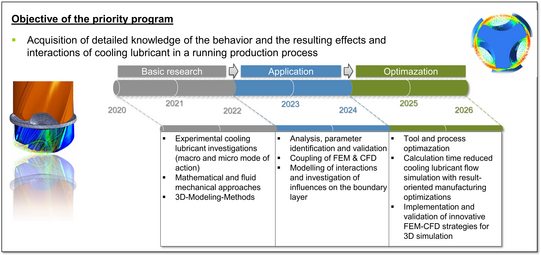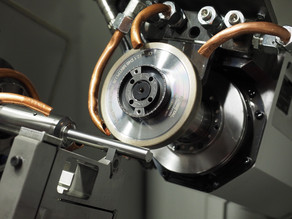SPP 2231 FluSimPro - Coupled mechanical and fluid dynamic simulation methods to realize efficient production processes
The scientific questions to be investigated within the proposed DFG priority program - SPP 2231 FluSimPro - focus on the detailed understanding of the behavior and the resulting effects of cooling lubricant (KSS) in a running production process, where the fluids used explicitly take over cooling, lubrication and coupled transport functions. Only with this understanding the extremely energy- and resource-intensive use of coolant lubricants can be controlled efficiently. Furthermore, the safe and economical machining of demanding materials can only be realized with an optimized use of cooling lubricant, which in turn requires fundamental knowledge of the interactions in the process.
Since this understanding on the relevant length and time scales can only be achieved inadequately with the help of experimental and measurement methods alone, new methods of flow simulation are to be developed in close cooperation between production engineering and fluid mechanics, numerics, mechanics and related disciplines. Another possibility is to qualify existing methods in such a way that they provide predictive and efficient tools that can be used to calculate the cooling lubricant behaviour and its effect. In combination with simulation tools, which already allow a certain degree of representation of the thermomechanical processes in production processes, the currently missing essential gap to complete process modeling can be closed. However, this coupling represents a great challenge for flow simulation. Here, approaches have to be developed or extended which take into account fluid-structure interactions, multiphysics and multi-phase flows.
From the point of view of the underlying simulation methods and their implementation, the associated flow processes are to be classified as extremely difficult since a large number of the numerical and algorithmic techniques cannot be easily integrated into existing in-house or commercial software packages. Especially the computational domains for flow simulations, which are a combination of narrow gaps and the complement of the production tool, which also rotates or changes its position at very high speed, require new methods of domain description and grid generation, especially when the transport of solid particles of arbitrary geometry (e.g. chips) in the fluid flow is considered as well. Furthermore, non-isothermal effects caused by the import of (non-Newtonian) cooling lubricants as well as aspects of partial filling in the course of multiphase fluidics with emulsions, solid particles and gas inclusions must be considered. Reactive components and anisotropic, turbulent mixing zones are also of importance.
This is due, among other things, to current developments in physical modelling, numerical flow solvers based on finite volume, finite element and Lattice-Boltzmann methods (LBM) as well as newer, grid-free simulation approaches such as the Smoothed Particle Hydrodynamics (SPH) method. In addition to the established methods, this method has only in recent years developed into a full-fledged computational method for solving large, practically relevant problems in fluid mechanics. While some relevant topics have already been worked on and solved, there are still many theoretical and practical challenges for which there is still a considerable need for research in the next years. The physically correct simulation of systems with free surfaces, changing topologies and multiphase materials is a rewarding research goal and very relevant for the applied priority program.





![[Translate to English:] [Translate to English:]](/storages/isf-mb/_processed_/a/1/csm_Wendel_Tiefbohrer_51a08eea1c.jpg)